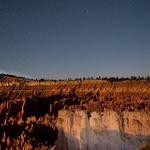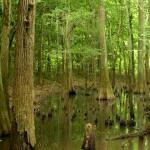Kate Heffernan is interning this summer at NCSE, where she is working with Minda Berbeco on teacher outreach activities. A recent graduate of the University of Florida, her undergraduate studies focused on environmental policy and education.

As you could probably deduce from my previous post, national parks were a huge part of my childhood. In these parks, I connected with nature for the first time; I was eager to learn and explore and there was no better place to learn about all kinds of science, from astronomy in Bryce Canyon to geology in the Grand Canyon. The parks served as giant outdoor classrooms. They fostered a sense of curiosity about the world around me and will always hold a special place in my heart (and brain for that matter!)
Unfortunately, the National Parks are no strangers to the effects of climate change. Across the country, the parks are changing quickly with the warming climate. Glacier National Park is losing the very glaciers that give the park its name; only twenty-six of the one hundred and fifty glaciers found in the park in 1850 are still intact today. In the south eastern corner of the country, the ecosystems of Everglades National Park are experiencing the effects of rising sea levels and resulting salt water intrusion. To address the growing threat of climate change, the National Park Service (NPS) is turning to scientific solutions, reducing its own carbon footprint, and implementing adaptation and education programs.
As a part of the education portion of their plan to address climate change, the NPS has an expansive set of educational resources available online for teachers. There are hundreds of resources to sort through, including many lessons focused on climate change—and best of all, for teachers worried about this, they are aligned with Common Core. As a native Floridian, I was drawn to the lesson on sea level rise in Everglades National Park. The detailed, three part lesson covers historic sea level changes in Florida, the difference between the effects of icebergs and ice sheets melting on sea level rise, and the current effects of sea level rise and climate change on Florida’s coastline. Instructions for an easy experiment that shows students the effects of ice sheet melt on sea level rise are included in the lesson plan. At the end of the lesson, there are a variety of assessment questions asked. For example, “Will this happen overnight, or over your lifetime? What can you do to plan/mitigate/adapt for this? What’s causing ice-sheets to melt?” This lesson provides insight on the past, present, and future of sea level rise.
Outside of the internet, the National Parks themselves are great educational resources. What's the best way to learn about geology? Visit the Grand Canyon and witness millions of years of erosion and geologic events right before your eyes. Want to teach your students about effects of ocean acidification on coral reefs? Biscayne National Park contains two hundred and seventy miles of reefs to explore and analyze. Are you covering the carbon cycle? Check out  Congaree National Park, South Carolina’s little-known gem of an old growth bottomland swamp and carbon sink. If you are lucky enough to live near any of the fifty nine unique national parks or the four hundred and seven sites run by the NPS, give your local park a call and set up a date for a field trip. The National Park Service has a sweeping variety of ranger programs that cover climate change, aiming to help students understand what is happening in the park, what is causing the changes, and what students can do to help address climate change. With all of these resources available and public lands just waiting to be explored, there is no better option than to get outside, experience the parks, and, come the fall, bring your class with you!
Congaree National Park, South Carolina’s little-known gem of an old growth bottomland swamp and carbon sink. If you are lucky enough to live near any of the fifty nine unique national parks or the four hundred and seven sites run by the NPS, give your local park a call and set up a date for a field trip. The National Park Service has a sweeping variety of ranger programs that cover climate change, aiming to help students understand what is happening in the park, what is causing the changes, and what students can do to help address climate change. With all of these resources available and public lands just waiting to be explored, there is no better option than to get outside, experience the parks, and, come the fall, bring your class with you!
Images are from Flickr users Tom Kelly http://bit.ly/1LB8zdT and Hunter Desportes http://bit.ly/1LBaEGR
